How One Wheelchair User Conquers The Sometimes Accessible NYC Transit System
Jan. 23, 2020, 9:21 a.m.
'Sometimes there’s a big gap, so you have to wheelie.'
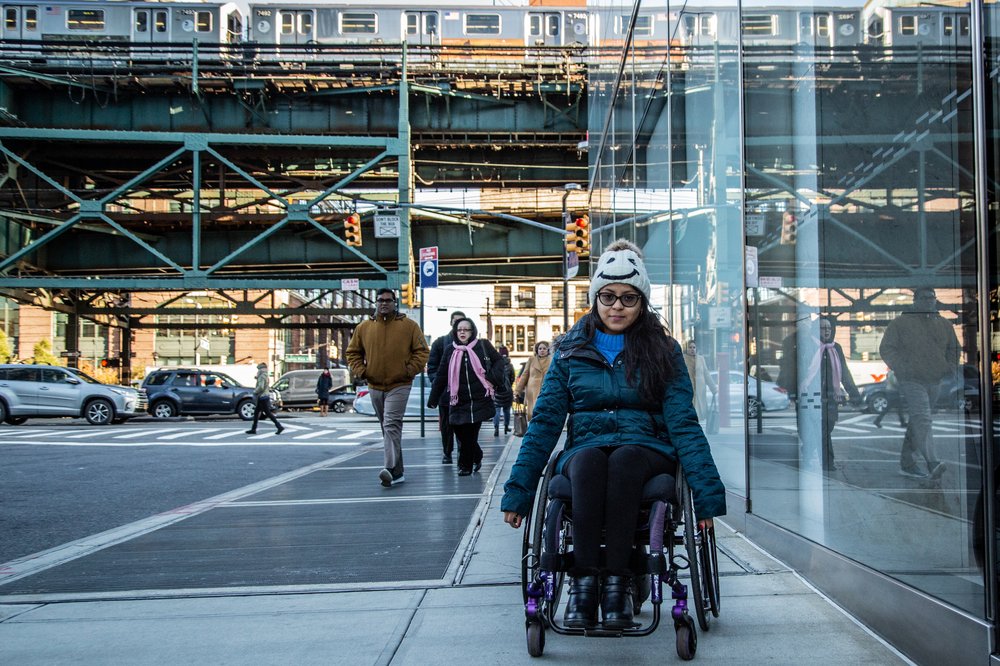
For all the talk about New York City’s lack of accessible transit, Katherine Valdez, who uses a wheelchair because of a spinal cord injury, moved to New York largely because of the subway.
“I used to live in Ecuador, and Ecuador is not accessible at all,” she said. “My family and I figured out that there is no future for me there. So we moved to this country, to have a better future.”
And like many apartment hunters, one of the first things she did after deciding to move was shop for neighborhoods on a subway map.
“I thought, oh, most of the places would be fully accessible for me. But then, surprise — not really!” she recalled. “I saw that not all the train stations have elevators, and that was a problem. I did research, I saw which neighborhoods has accessible train stations, or buses. And so far, this is a pretty decent one!”
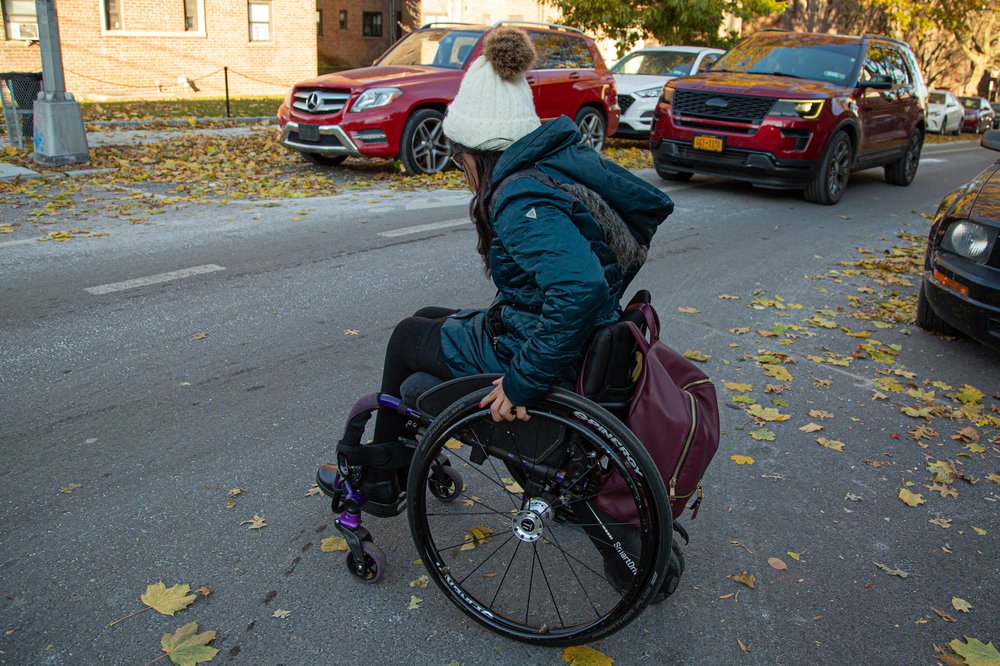
Her neighborhood — Briarwood, Queens — is where I met her on a recent morning at 8:16 a.m., the time she leaves every weekday for the half-mile trip to the Union Turnpike - Kew Gardens station. From there, she takes an elevator down to the mezzanine; swipes her half-price MetroCard, pushes through a gate; takes another elevator down to the Manhattan-bound platform; and rides the E train about 25 minutes to Queens Plaza. Then, it’s another two elevators up, before she rolls a few blocks to her office, in Long Island City.
On a good day, she’ll do this in the morning, and then the exact reverse on the way home. The day we commuted together was not a good day.
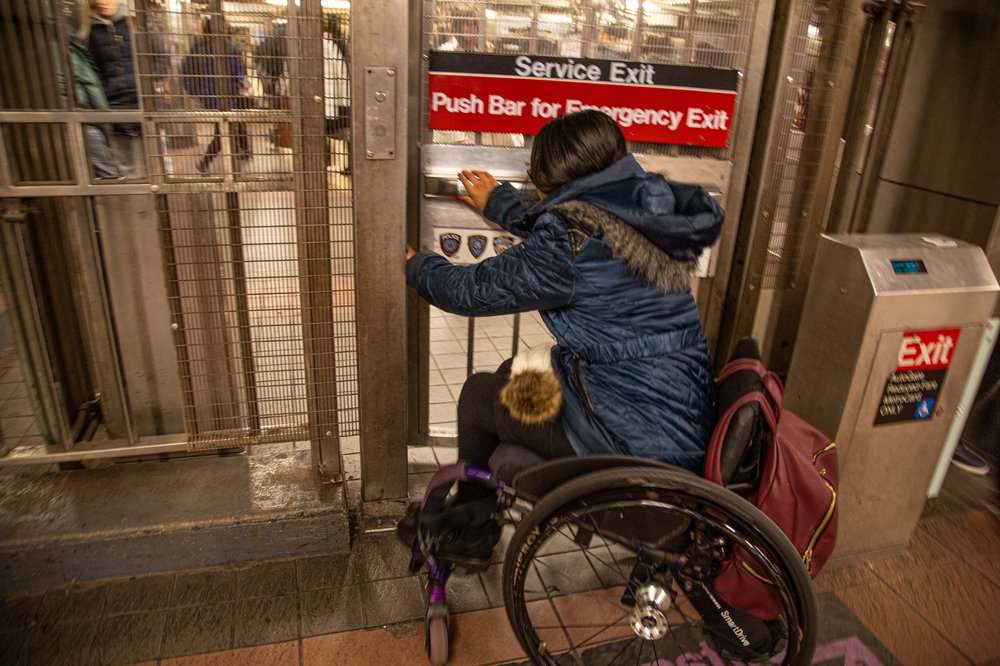
What Valdez does on a regular basis — go to an office (she works for a city agency), run errands, work out at the gym (in the winter) or in Central Park or Flushing Meadows Corona Park (in the summer), all in a wheelchair — puts her in a tiny sliver of New York City’s commuting and accessibility Venn diagram.
There are an estimated 100,000 wheelchair users in the city, according to a 2019 report from the Mayor’s Office for People With Disabilities. But only one in five New Yorkers with a disability is employed. Of the people in that group, not all commute to a workplace every day. And even for wheelchair users who could manage a daily subway commute, plenty of workplaces make getting a job prohibitive.
“It took me a while to get a job, because not all the companies are willing to accommodate you,” Valdez said. “They’ll say there are budget problems, ‘Oh, we’re not sure we can do this for you.’ It is [illegal], but they try to avoid it in a diplomatic way. What else can you do?”
Listen to reporter James Ramsay's story for WNYC:
When we talk about accessibility—or the lack thereof—in New York City, what often comes up is the futile experience of trying to use Access-a-Ride, the heavily subsidized car-and-van service that needs to be booked 24 hours in advance, often takes passengers on circuitous routes to pick up other passengers, and is known for long delays.
What’s also true: Of the 154,000 people registered as Access-a-Ride users, 71 percent are over the age of 65. It’s an imperfect service for getting to a doctor’s appointment or church on Sunday, but it works. It’s really an imperfect service for a young person with a busy, mobile life.
Valdez and I met earlier this year at a handcycling workout in Central Park, during a We The Commuters project about cycling groups in the city. Most of the athletes were retired men who’d taken up handcycling after suffering injuries or amputations in the Vietnam War. As a 26-year-old woman, Valdez stood out. But handcycling is also crucial to her life as a commuter.
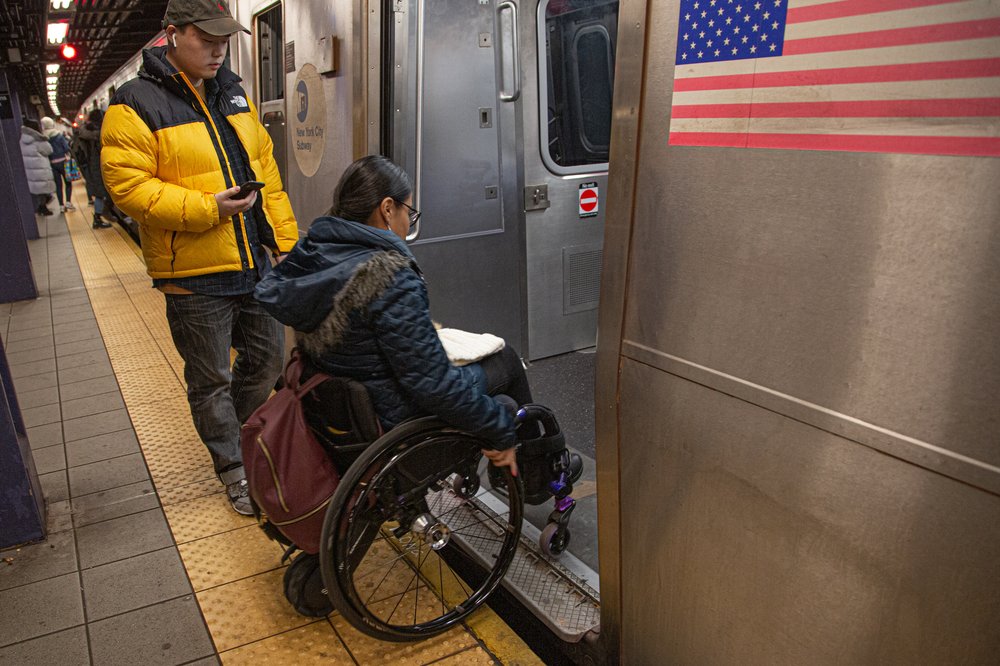
“The trains here, sometimes there’s a big gap, so you have to wheelie,” she said, slightly launching onto the E train at Union Turnpike - Kew Gardens. “And for that, you need very good upper body strength. Same muscles I use for rowing or handcycle, I use for my daily life.”
(Valdez also rows crew; she said she’s hoping to make the next Paralympic team.)
After work, she had an errand to run at Macy’s (new boots), so we got on an M train at Queens Plaza, heading towards 34 St - Herald Square. On the train, she started checking her phone. Bad news.
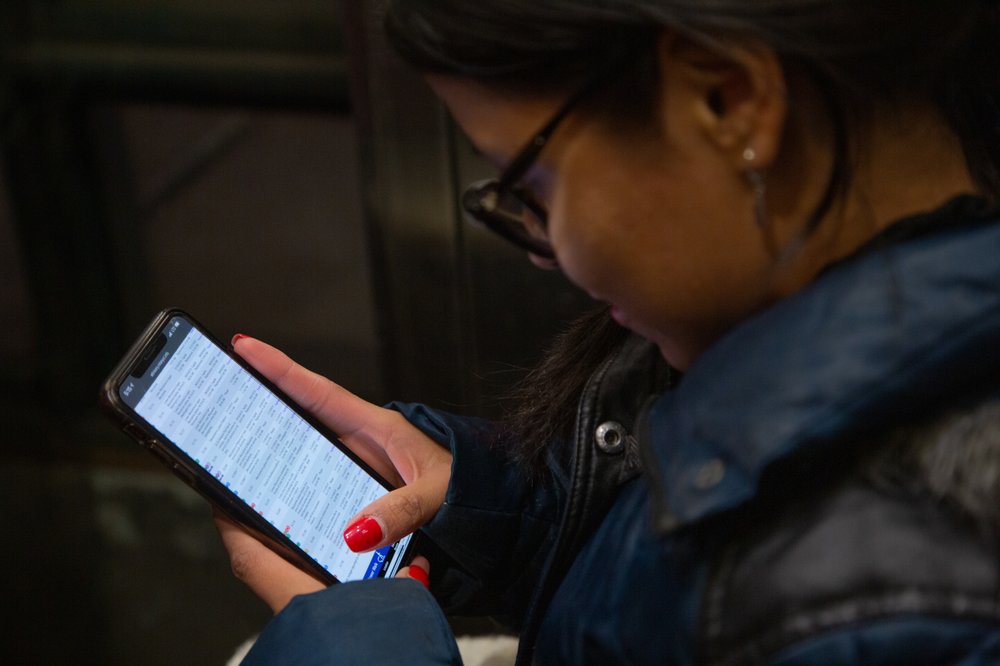
“As you can see, Kew Gardens - Union Turnpike is out of service,” she said. She was looking at an MTA website she keeps pulled up, which has hourly updates on elevator work. “I will have to get off at Forest Hills and then take the bus. It’ll be a long ride. According to this, it’s going to be under repair until tomorrow morning, so I hope it won’t be under repair when I go to work.”
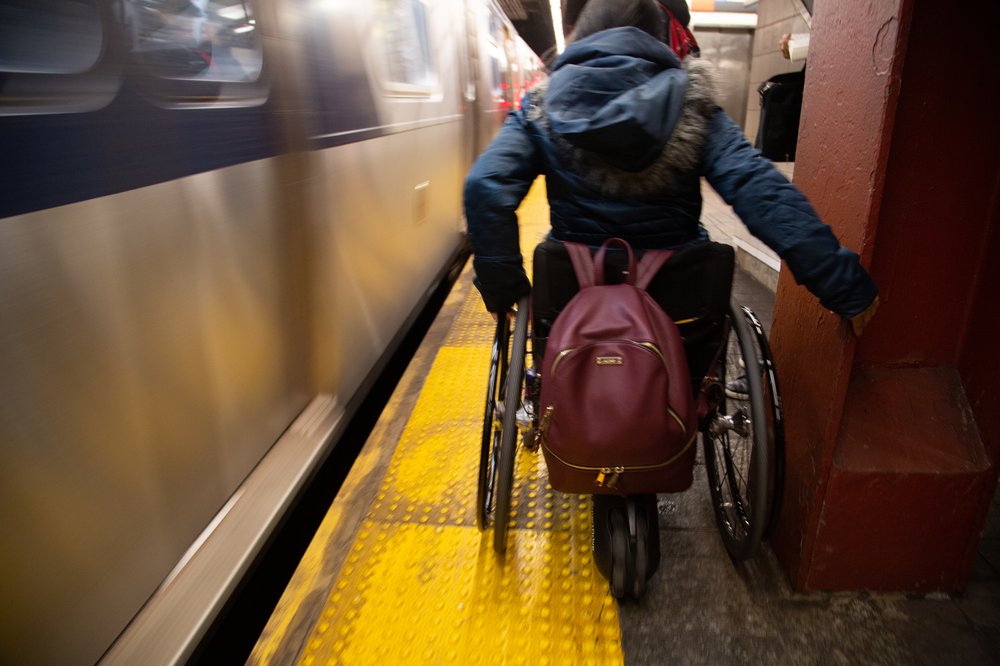
When we finally arrived at 34th Street, she pushed through an extremely narrow platform (“I’m lucky that my wheelchair is not wider”); rode up a smelly elevator (“This is clean, believe it or not”); passed a loud busker (Creed, “With Arms Wide Open”); and reached one of the busiest intersections in Manhattan, which she darted across to get into a department store that, if you know where to look, has loads of wheelchair ramps.
“It would be nice if they said, ‘between this date, these hours, the elevators are going to be under maintenance. Please plan ahead.’ But they don’t,” she said, looking again at the MTA website on the E train back towards home. “Sometimes, if there’s nothing serious, just another regular maintenance thing, they will let me use it. I will have to wait about 10, 15 minutes. But at least I can use the elevator.”
This night’s elevator disruption was pretty mild by comparison. Having to get off a stop early and take the bus the rest of the way home is easy. It’s when these issues happen mid-commute that a tedious nightmare ensues.
“For example, if the mezzanine-to-street elevator isn’t working in Queens Plaza,” she said, “I have to go back to [Roosevelt Av-Jackson Heights], transfer to the F train, go to Queensbridge, and then roll to my work. That’s about a mile. Last time I had that problem was two weeks ago. But in the summer it was, like, every week.”
When we made it to the Forest Hills stop, it was a race to get up the two (working!) elevators and catch this bus.
“Looks like [the bus] is two stops away,” she says, looking at her phone. “I don’t think we’re gonna make it.”
We reached a crosswalk. I agreed to run as fast as her slightly-motorized chair will move. We get the walk signal. And we chase the bus down...only for the bus’s wheelchair ramp to fall short of the curb.
“It didn’t reach the sidewalk,” Valdez said. “It’s supposed to be over the curb.”
Then, the bus driver folded up the ramp, closed the door, and lurched bac.
“Oh, she’s moving!” exclaimed Valdez. “Not all the drivers do that. There’s times where I have to [board] the bus in the middle of the street.”
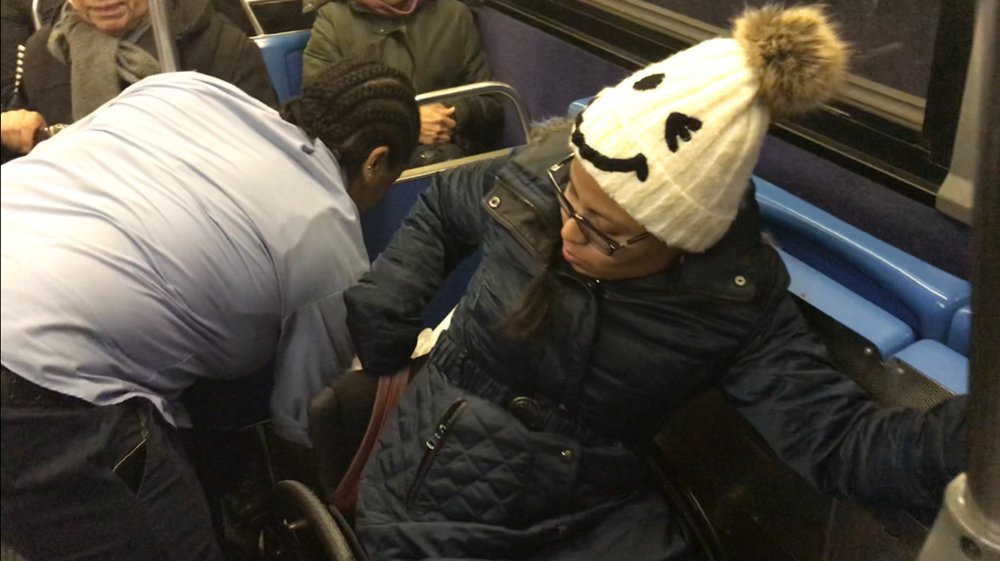
Valdez got on, the (very kind) driver clipped her into the designated wheelchair spot, we pressed the blue button when we’re a block away from her home (“It makes two ding-dongs, so the driver knows a wheelchair user is getting off at this bus stop”), and we were back down the ramp and home. It’s 7 p.m., two hours after her work day ended, and one hour after she scored a new pair of shoes.
“We were lucky,” she said. “The train was on time, the bus was on time.”
We are lucky, not only because the bus was on time, but because that bus line exists at all.
“If people need to go out of the metro station one [stop] before their home, the likelihood that there’s a bus going directly on a fixed route to your home is super low,” said Joël Hazan, who studies mobility for Boston Consulting Group.
Though New York City Transit’s ambitious $51.5 billion Fast Forward plan includes elevator installations in 70 new subway stations over the next five years, Hazan argued that making every station fully accessible is not only impractically expensive — it’s incomplete. Many people, and especially those lower on the income scale, don’t live close enough to a subway station to independently get there if they have mobility issues.
He pointed to the so-called microtransit experiments that have run in Seattle and Los Angeles, offering on-demand shuttles from people’s homes to the closest accessible train or bus stop.
For Valdez, though, a five-year infrastructure plan or a micromobility pilot isn’t getting her around every day. And yet, she’s making it work, through a combination of the MTA’s imperfect offerings, and her own commitment.
“Despite the elevator [being] out of service and everything, it wasn’t a really bad day,” she said once we were back on her block.
The next morning, the elevator is back in order, just as the website said it would be, and she was at work at 9 a.m.
What gets in the way of making your commute fully accessible? As We The Commuters looks into your questions about accessibility in NYC transit, we’re looking to you to help build a Visual Checklist to send to the MTA. Here’s what we want: Send us a picture of the bumps, blocks, and design flaws that make your commute inaccessible. Also include a few words about you and your accessibility needs. Share it on Twitter using #WeTheCommuters, or send us an email at WeTheCommuters@wnyc.org. We’ll compile your entries and share it with the MTA.